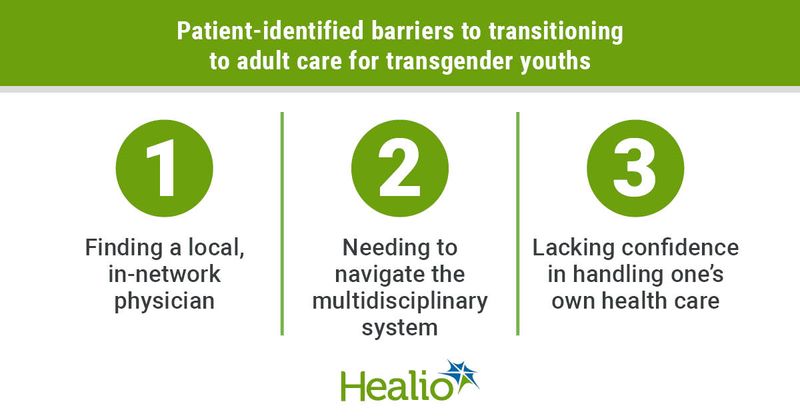Collaboration, transition plan important for transgender youths shifting to adult care
Collaboration, understanding a youth’s goals and detailing a transition plan are three ways providers can help transgender adolescents shift from pediatric to adult care, according to findings published in LGBT Health.


“Our study describes many strategies that may be implemented into most clinics without disrupting any existing protocols and procedures,” Lauren Kuper, PhD, a licensed psychologist in the Gender Education and Care Interdisciplinary Support (GENECIS) program at Children’s Health in Dallas and assistant professor of psychiatry at the University of Texas Southwestern Medical School, and Tri Pham, a medical student at the University of Texas Southwestern Medical School, told Healio. “Our hope is that these findings will help address common barriers faced. Implementation of these strategies may help improve overall access to gender-affirming care and clinics, and patient ability to independently manage their health care. They may also help bridge the potential time gap between pediatric and adult care, hopefully preventing many from falling through the cracks.”

Kuper, Pham and colleagues recruited adolescents and young adults aged 13 to 21 years and their parents from a multidisciplinary clinic for transgender youths in Dallas. Pediatric and adult health care providers, including physicians, nurses, nurse practitioners and social workers, were also recruited from clinics offering gender-affirming care for youths in Dallas. All participants completed an online sociodemographic survey. Five focus groups were conducted online from February to March 2019. Separate groups were created for adolescents younger than 18 years, young adults aged 18 to 21 years, parents of adolescents younger than 18 years, parents of young adults aged 18 to 21 years and providers. Questions in the focus groups examined unmet health care needs, barriers to obtaining gender-affirming care and recommendations for improving the transition from pediatric to adult care.
Barriers in transitioning to adult care
There were 29 youths, 27 parents and 10 providers who participated in the study. The participants identified five barriers to current care and the transition to adult care. All of the focus groups said there were significant difficulties in finding a local gender-affirming physician. Cost was another barrier, with all groups reporting high costs even with insurance, and a lack of in-network providers and insufficient patient readiness to navigate insurance.
Most adolescent participants said they were anxious about transitioning to adult care and had a desire to stay with their pediatric provider as long as possible. Both parents and youths said they struggled to work with many different specialties at the same time, including social work, endocrinology, pharmacy and psychiatry. Finally, all groups expressed concern about the ability for transgender youths to oversee their own health care.
“Transgender youth who form a close bond with their pediatric provider often express great hesitancy in starting the transition process,” Kuper and Pham said. “This bond creates an environment of security and comfort that they did not want to leave. Another interesting finding is that families often expressed difficulties navigating the multidisciplinary system needed for comprehensive gender-affirming care, which is an issue that providers never brought up in our study. This discongruity denotes an important area of focus. Providers need to remain cognizant of the challenges faced by families and play a bigger role in improving patient experience and facilitating access.”
Improving transition to adult care transition
Participants gave several recommendations for improving the transition from pediatric to adult care. Almost all adolescents stated it was important to have their gender identity validated and embraced by their adult provider. Both parents and youths said they primarily relied on trusted sources such as their pediatric provider, local transgender community members and other families for referrals to adult providers. Most participants said they believed that taking gradual steps rather than a rapid change would help adolescents establish patient independence. Some adolescents said they felt that their pediatric providers did not fully understand their goals and desires and it was important to specifically detail gender transition goals to their new adult provider. Finally, families recommended creating a timeline to facilitate preparation to transfer to adult care.
“The next step is using these findings to inform specific protocols that may improve the transition process,” Kuper and Pham said. “Further studies should focus on assessing the feasibility and efficacy of the implemented changes, hopefully leading to robust, evidence-based guidelines in the future.”
For more information:
Lauren Kuper, PhD, can be reach at laura.kuper@childrens.com.
Tri Pham can be reached at tri.pham@utsouthwestern.edu.


